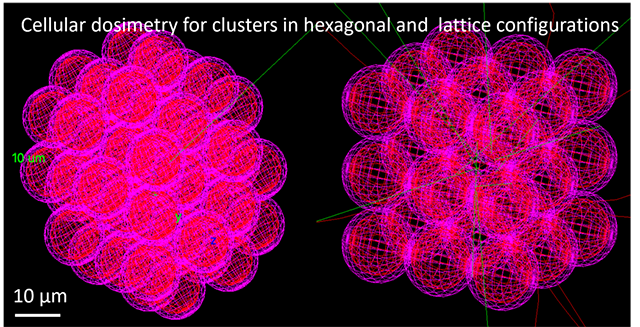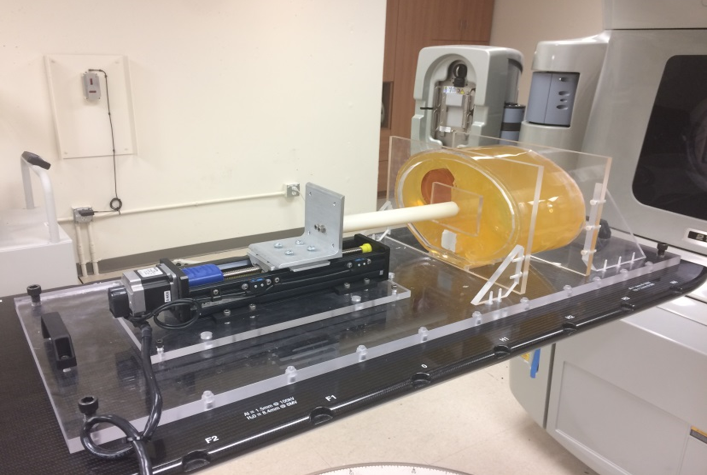Image Guidance

This is an accordion element with a series of buttons that open and close related content panels.
Bryan Bednarz, PhD | Radiological Engineering and Design (RED) Laboratory
The mission of the RED Lab is to advance the beneficial uses of ionizing radiation for cancer treatment. Together with both clinical and industrial partners, the RED Lab identifies future challenges that will likely impede the quality and effectiveness of cancer care to patients. We aim to introduce disruptive ideas and translational technology that will help address these challenges through the use of computational modeling and simulation and instrumentation design and development. While much of our attention is devoted to the advancement of radiation therapy, the laboratory also addresses problems encountered in imaging, immunotherapy, and surgery.
Walter Block, PhD
Dr. Block’s research interests include MR angiography and cardiac imaging – specifically designing real-time magnetic resonance acquisition and processing algorithms and systems for these procedures.
Dr. Block Profile
Weibo Cai, PhD | Cai Research Group
Research of the Cai Group is focused on three areas: 1) development of multimodality molecular imaging agents; 2) molecular therapy of cancer; and 3) nanotechnology and its biomedical applications. Although our major disease focus is on cancer, the key feature of molecular imaging/therapy is that it is molecular specific instead of disease specific. The same molecularly-targeted agents can be applied in various diseases as long as the particular target is present or over-expressed. In addition, we are collaborating with a number of research groups both within UW and at other universities, where imaging can serve as an invaluable tool to answer the specific research questions posed.
Carri Glide-Hurst, PhD
Dr. Glide-Hurst’s primary areas of research and clinical expertise include magnetic resonance simulation (MR-SIM) and MR-guided radiation therapy.
Robert Jeraj, PhD | Image Guided Therapy Group
Dr. Jeraj’s main research focus is to improve cancer treatment by furthering the understanding of treatment resistance and the impact of tumor heterogeneity on treatment response using molecular imaging. Their work analyzes patient data obtained from clinical trials to implement imaging biomarkers describing heterogeneity to understand both the development of treatment resistance and patient survival. Using the clinical trial data they aim to create models, machine-learning or computational, that further the understanding of disease progression.
Michael Speidel, PhD | Image-Guided Interventions Lab
The mission of Dr. Speidel’s laboratory is to develop novel imaging tools for interventional radiologists and cardiologists through the application of physics, advanced imaging technology, and innovative algorithms.
Radiation Therapy

This is an accordion element with a series of buttons that open and close related content panels.
Bryan Bednarz, PhD | Radiological Engineering and Design Laboratory
The mission of the RED Lab is to advance the beneficial uses of ionizing radiation for cancer treatment. Together with both clinical and industrial partners, the RED Lab identifies future challenges that will likely impede the quality and effectiveness of cancer care to patients. We aim to introduce disruptive ideas and translational technology that will help address these challenges through the use of computational modeling and simulation and instrumentation design and development. While much of our attention is devoted to the advancement of radiation therapy, the laboratory also addresses problems encountered in imaging, immunotherapy, and surgery.
Wesley Culberson, PhD | Wisconsin Medical Radiation Research Center
Research Interests
- Metrology
- Ionization chambers
- Radiation therapy
- Radiation dosimetry in diagnostic radiology and radiotherapy
- Thermoluminescent Dosimeters (TLDs)
- Calorimetry
Larry DeWerd, PhD | Wisconsin Medical Radiation Research Center
Radiation metrology, including calibration of ionization chambers, calorimetry, free air chambers. Radiation dosimetry in diagnostic radiology brachytherapy, and radiotherapy, quality assurance in radiology and radiotherapy, luminescence for dosimetry (TLD).
Wisconsin Medical Radiation Research Center
Carri Glide-Hurst, PhD
Dr. Glide-Hurst’s primary areas of research and clinical expertise include magnetic resonance simulation (MR-SIM) and MR-guided radiation therapy.
Theranostics

This is an accordion element with a series of buttons that open and close related content panels.
Bryan Bednarz, PhD | Radiological Engineering and Design Laboratory
The mission of the RED Lab is to advance the beneficial uses of ionizing radiation for cancer treatment. Together with both clinical and industrial partners, the RED Lab identifies future challenges that will likely impede the quality and effectiveness of cancer care to patients. We aim to introduce disruptive ideas and translational technology that will help address these challenges through the use of computational modeling and simulation and instrumentation design and development. While much of our attention is devoted to the advancement of radiation therapy, the laboratory also addresses problems encountered in imaging, immunotherapy, and surgery.
Weibo Cai, PhD | Cai Research Group
Research of the Cai Group is focused on three areas: 1) development of multimodality molecular imaging agents; 2) molecular therapy of cancer; and 3) nanotechnology and its biomedical applications. Although our major disease focus is on cancer, the key feature of molecular imaging/therapy is that it is molecular specific instead of disease specific. The same molecularly-targeted agents can be applied in various diseases as long as the particular target is present or over-expressed. In addition, we are collaborating with a number of research groups both within UW and at other universities, where imaging can serve as an invaluable tool to answer the specific research questions posed.
Jon Engle, PhD | Cyclotron Research Group
Dr. Engle’s work is actively pursuing novel accelerator targetry and radiochemistry for the production of radionuclides that are useful in medical diagnosis, disease treatment, basic science and industrial applications.
Paul Ellison, PhD
Dr. Ellison’s research interests utilize the principles and techniques of nuclear and radiochemistry to address challenges in the field of nuclear medicine. Drawing from the fields of nuclear chemical elemental separations, small molecule synthetic radiochemistry, preclinical cancer models, and preparation of radiopharmaceuticals for human research, Ellison’s work focuses on the development of small molecules radiolabeled with matched positron-emitting and Auger-electron-emitting therapeutic radionuclides for the planning and execution of targeted radionuclide therapy of cancer.
Reinier Hernandez, PhD | Advanced Radiotheranostic Laboratory (ART)
Advanced Radiotheranostic Laboratory (ART)
- Radiochemistry applications in biomedical research
- Targeted radionuclide therapy – theranostics
- Radio-immunooncology
- Neutron capture therapy